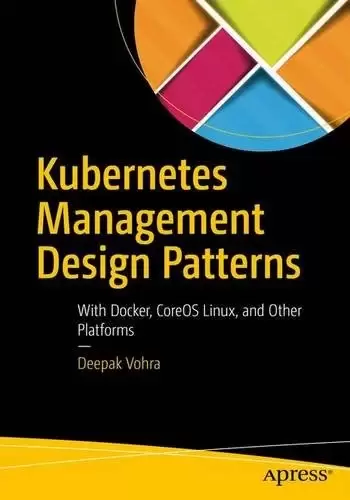
Book Description
Take container cluster management to the next level; learn how to administer and configure Kubernetes on CoreOS; and apply suitable management design patterns such as Configmaps, Autoscaling, elastic resource usage, and high availability. Some of the other features discussed are logging, scheduling, rolling updates, volumes, service types, and multiple cloud provider zones.
The atomic unit of modular container service in Kubernetes is a Pod, which is a group of containers with a common filesystem and networking. The Kubernetes Pod abstraction enables design patterns for containerized applications similar to object-oriented design patterns. Containers provide some of the same benefits as software objects such as modularity or packaging, abstraction, and reuse.
CoreOS Linux is used in the majority of the chapters and other platforms discussed are CentOS with OpenShift, Debian 8 (jessie) on AWS, and Debian 7 for Google Container Engine.
CoreOS is the main focus becayse Docker is pre-installed on CoreOS out-of-the-box. CoreOS:
- Supports most cloud providers (including Amazon AWS EC2 and Google Cloud Platform) and virtualization platforms (such as VMWare and VirtualBox)
- Provides Cloud-Config for declaratively configuring for OS items such as network configuration (flannel), storage (etcd), and user accounts
- Provides a production-level infrastructure for containerized applications including automation, security, and scalability
- Leads the drive for container industry standards and founded appc
- Provides the most advanced container registry, Quay
Docker was made available as open source in March 2013 and has become the most commonly used containerization platform. Kubernetes was open-sourced in June 2014 and has become the most widely used container cluster manager. The first stable version of CoreOS Linux was made available in July 2014 and since has become one of the most commonly used operating system for containers.
What You’ll Learn
- Use Kubernetes with Docker
- Create a Kubernetes cluster on CoreOS on AWS
- Apply cluster management design patterns
- Use multiple cloud provider zones
- Work with Kubernetes and tools like Ansible
- Discover the Kubernetes-based PaaS platform OpenShift
- Create a high availability website
- Build a high availability Kubernetes master cluster
- Use volumes, configmaps, services, autoscaling, and rolling updates
- Manage compute resources
- Configure logging and scheduling
Who This Book Is For
Linux admins, CoreOS admins, application developers, and container as a service (CAAS) developers. Some pre-requisite knowledge of Linux and Docker is required. Introductory knowledge of Kubernetes is required such as creating a cluster, creating a Pod, creating a service, and creating and scaling a replication controller. For introductory Docker and Kubernetes information, refer to Pro Docker (Apress) and Kubernetes Microservices with Docker (Apress). Some pre-requisite knowledge about using Amazon Web Services (AWS) EC2, CloudFormation, and VPC is also required.
Table of Contents
Part I: Platforms
Chapter 1: Kubernetes on AWS
Chapter 2: Kubernetes on CoreOS on AWS
Chapter 3: Kubernetes on Google Cloud Platform
Part II: Administration and Configuration
Chapter 4: Using Multiple Zones
Chapter 5: Using the Tectonic Console
Chapter 6: Using Volumes
Chapter 7: Using Services
Chapter 8: Using Rolling Updates
Chapter 9: Scheduling Pods on Nodes
Chapter 10: Configuring Compute Resources
Chapter 11: Using ConfigMaps
Chapter 12: Using Resource Quotas
Chapter 13: Using Autoscaling
Chapter 14: Configuring Logging
Part III: High Availability
Chapter 15: Using an HA Master with OpenShift
Chapter 16: Developing a Highly Available Website
中文:
书名:Kubernetes Management Design Patterns: With Docker, CoreOS Linux, and Other Platforms
容器集群管理更上一层楼;了解如何在CoreOS上管理和配置Kubernetes;并应用合适的管理设计模式,如Configmap、Autoscaling、弹性资源使用和高可用性。讨论的其他一些功能包括日志记录、计划、滚动更新、卷、服务类型和多个云提供商区域。
Kubernetes中模块化容器服务的原子单位是Pod,它是一组具有公共文件系统和网络的容器。Kubernetes Pod抽象支持容器化应用程序的设计模式,类似于面向对象的设计模式。容器提供了一些与软件对象相同的好处,如模块化或打包、抽象和重用。
大部分章节使用的是CoreOS Linux,讨论的其他平台是带有OpenShift的CentOS、基于AWS的Debian 8(Jessie)以及用于Google Container Engine的Debian 7。
CoreOS是主要的焦点,因为Docker是开箱即用预装在CoreOS上的。酷睿操作系统:
- 支持大多数云提供商(包括Amazon AWS EC2和Google Cloud Platform)和虚拟化平台(如VMWare和VirtualBox)
- 为声明性地配置网络配置(法兰绒)、存储(Etcd)和用户帐户等操作系统项目提供云配置
- 为集装箱化应用程序提供生产级基础设施,包括自动化、安全性和可伸缩性
- 领导推动集装箱行业标准,并成立了APPC
- 提供最先进的集装箱注册中心Quay
Docker于2013年3月以开源形式提供,已成为最常用的集装箱化平台。Kubernetes于2014年6月开源,现已成为使用最广泛的容器集群管理器。*CoreOS Linux的第一个稳定版本于2014年7月推出,自那以来已成为Containers最常用的操作系统之一。
你会学到什么?
- 将Kubernetes与Docker一起使用
- 在AWS上的CoreOS上创建Kubernetes集群
- 应用集群管理设计模式
- 使用多个云提供商区域
- 使用Kubernetes和Ansible等工具
- 了解基于Kubernetes的PaaS平台OpenShift
- 创建高可用性网站
- Build a high availability Kubernetes master cluster
- 使用卷、配置映射、服务、自动调整和滚动更新
- 管理计算资源
- 配置日志记录和计划
Who This Book Is For
Linux管理员、CoreOS管理员、应用程序开发人员和容器即服务(CAAS)开发人员。需要具备一些Linux和Docker的必备知识。需要Kubernetes的入门知识,如创建集群、创建Pod、创建服务以及创建和扩展复制控制器。有关Docker和Kubernetes的介绍性信息,请参阅Pro Docker(APRESS)和Kubernetes MicroServices with Docker(APRESS)。还需要具备一些使用Amazon Web Services(AWS)EC2、CloudForms和VPC的必备知识。
Table of Contents
Part I: Platforms
第1章:AWS上的库伯内斯
第2章:CoreOS on AWS上的Kubernetes
第三章:谷歌云平台上的Kubernetes
第二部分:管理和配置
第4章:使用多个区域
第5章:使用构造控制台
第6章:使用卷
第7章:使用服务
第8章:使用滚动更新
Chapter 9: Scheduling Pods on Nodes
第10章:配置计算资源
第11章:使用配置映射
第12章:使用资源配额
第13章:使用自动缩放
第14章:配置日志记录
Part III: High Availability
第15章:在OpenShift中使用HA主机
第16章:开发高度可用的网站
评论前必须登录!
注册